-
CATEGORY ::
- All Seeds /
- All Flower Seeds /
- All Poppy Seeds
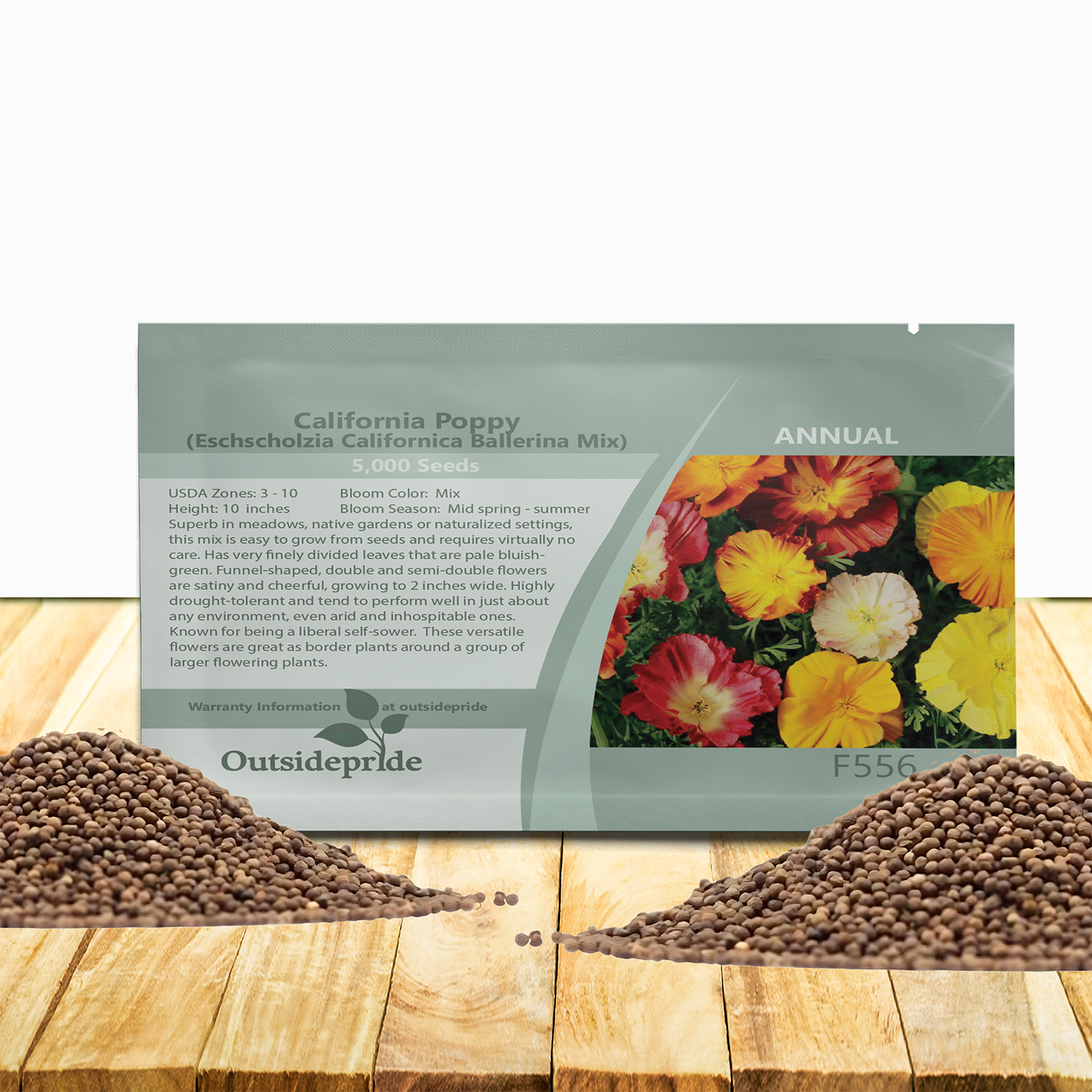

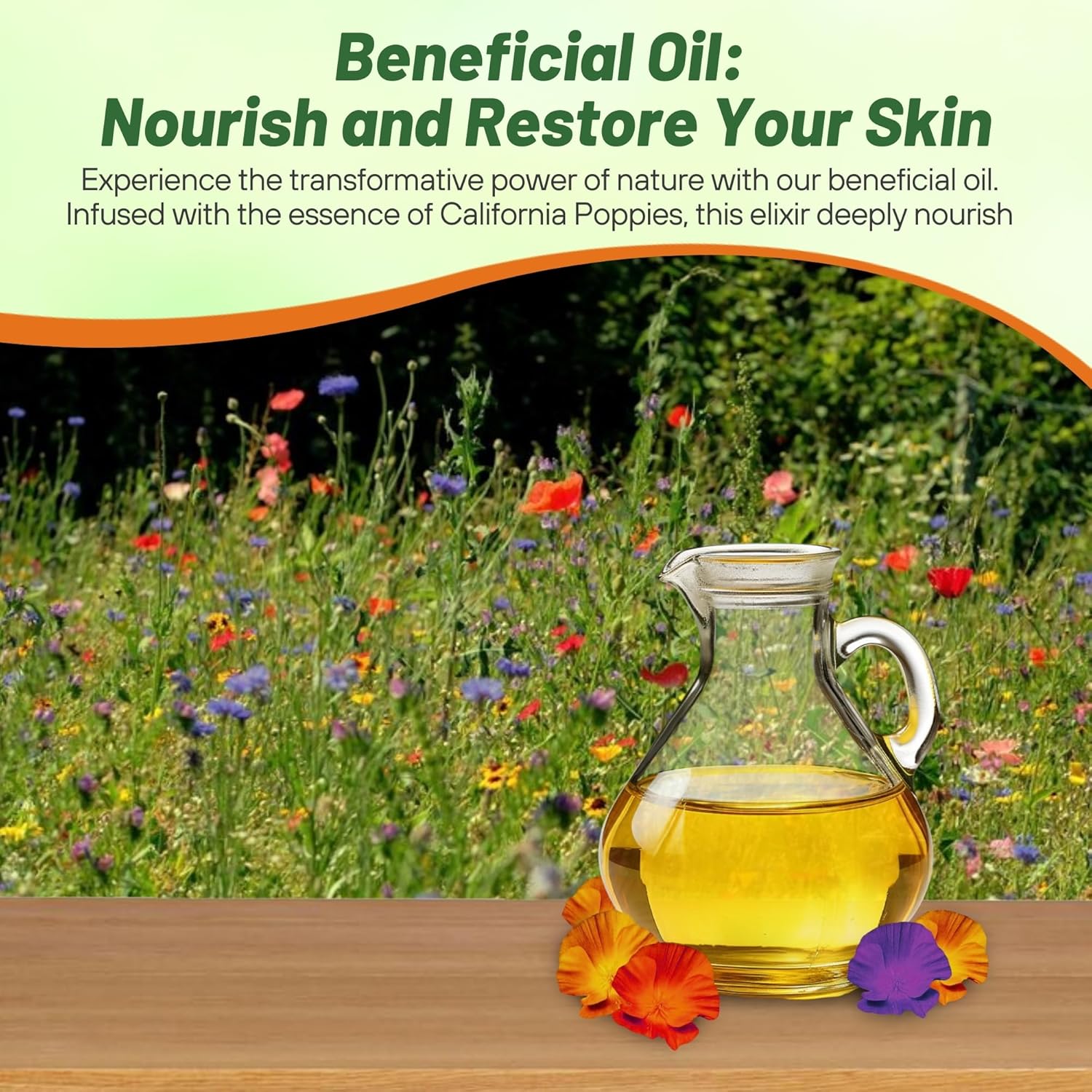
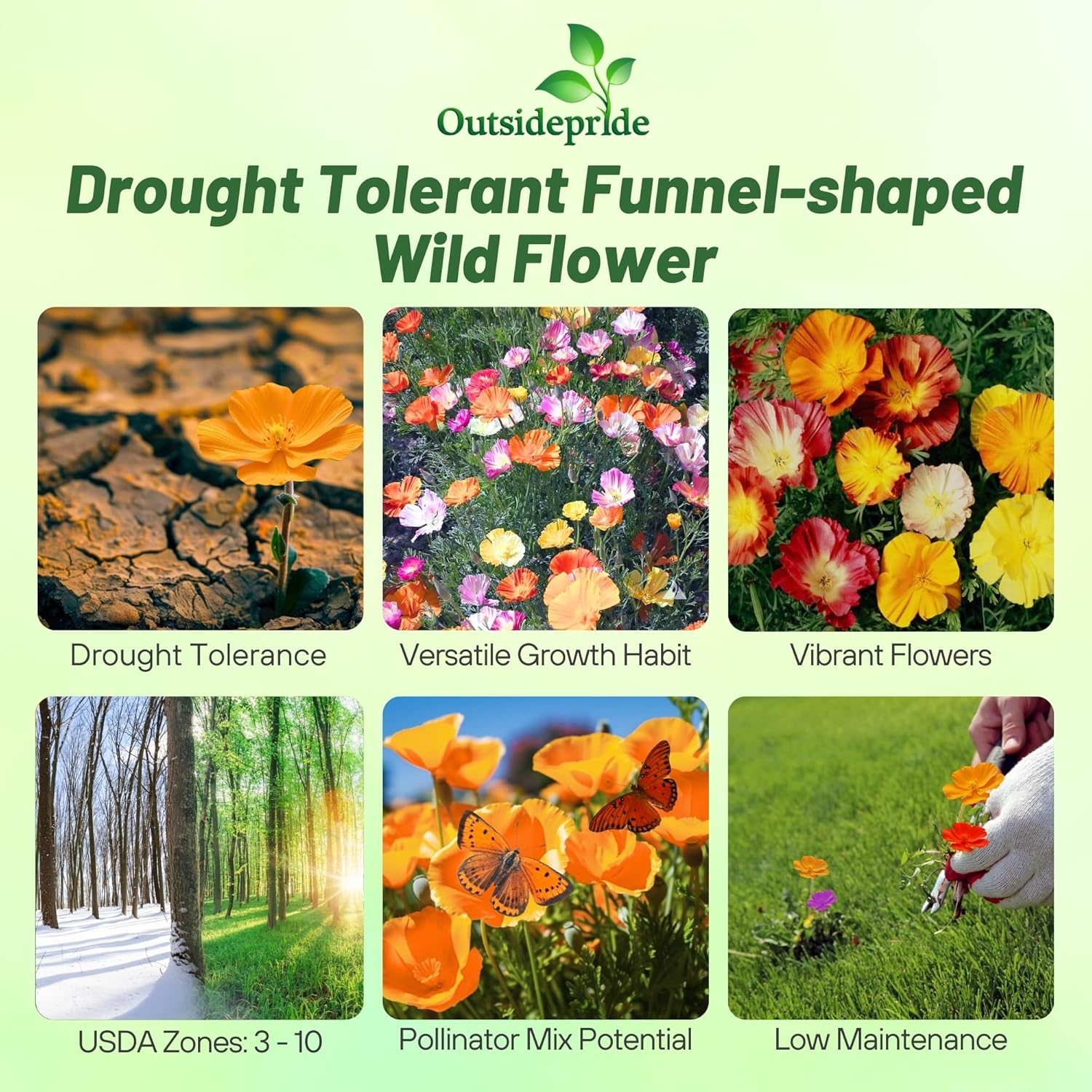
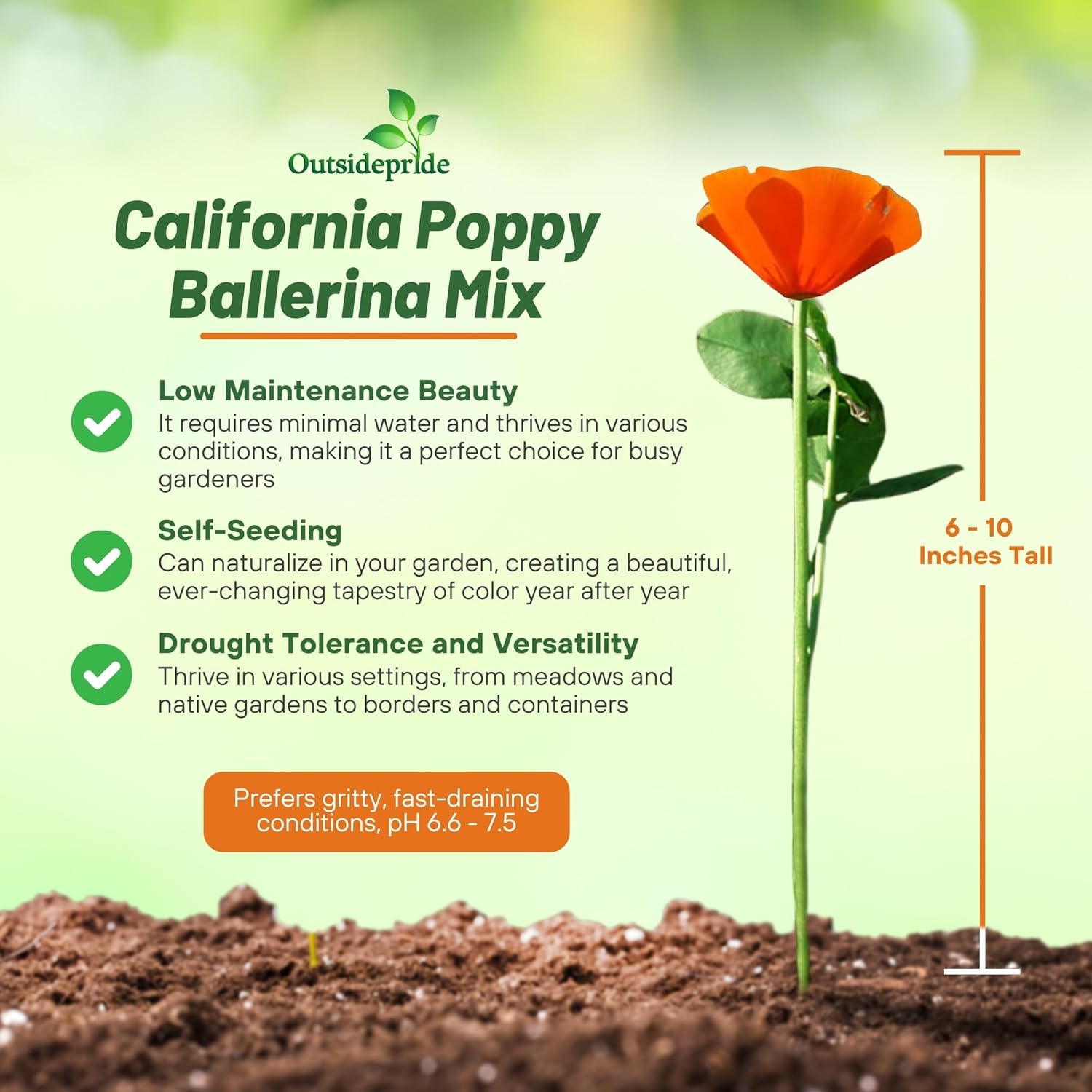
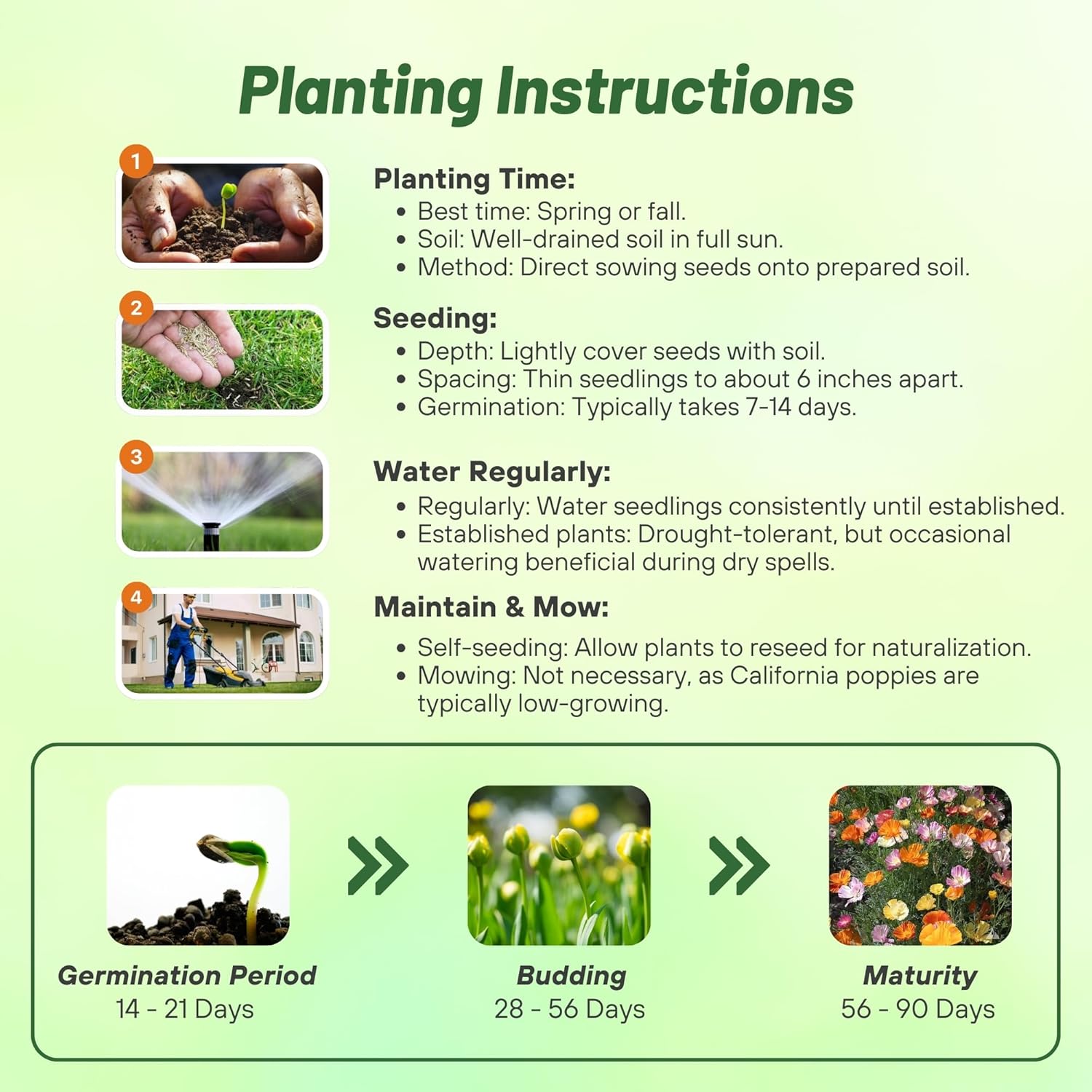

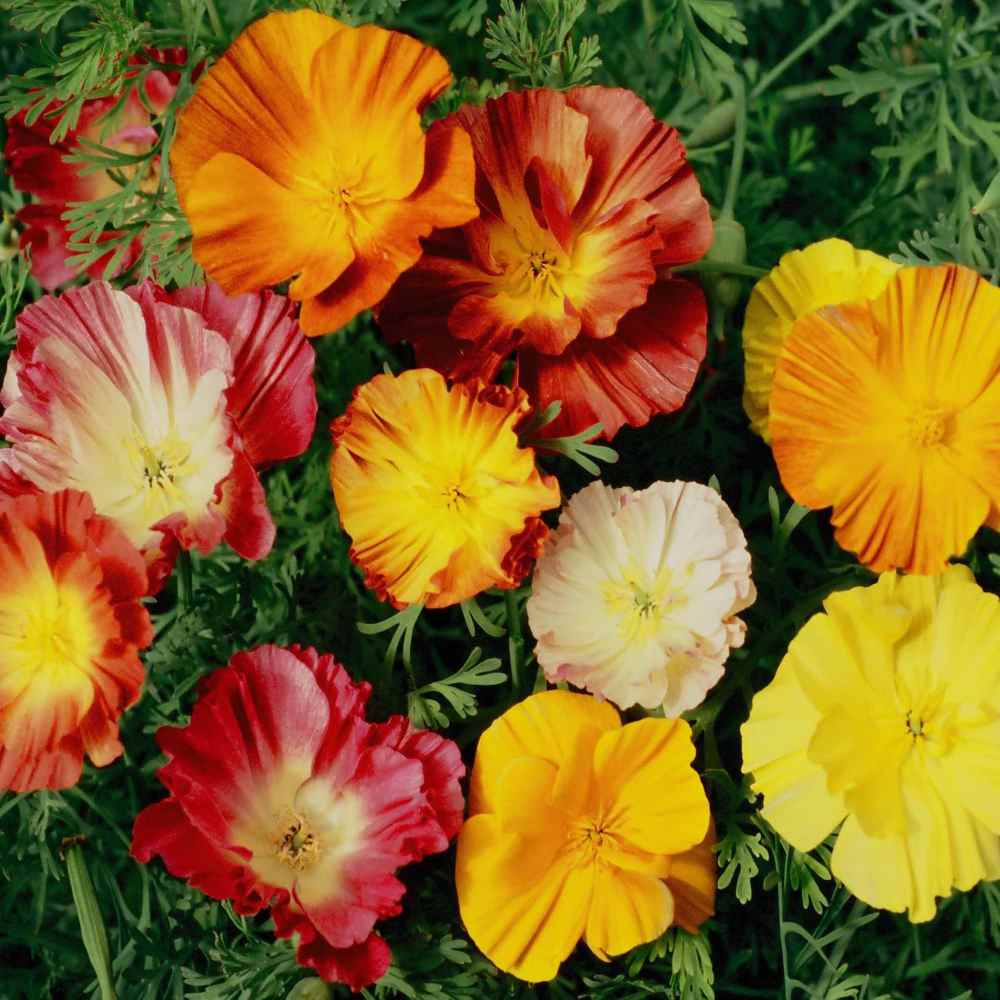
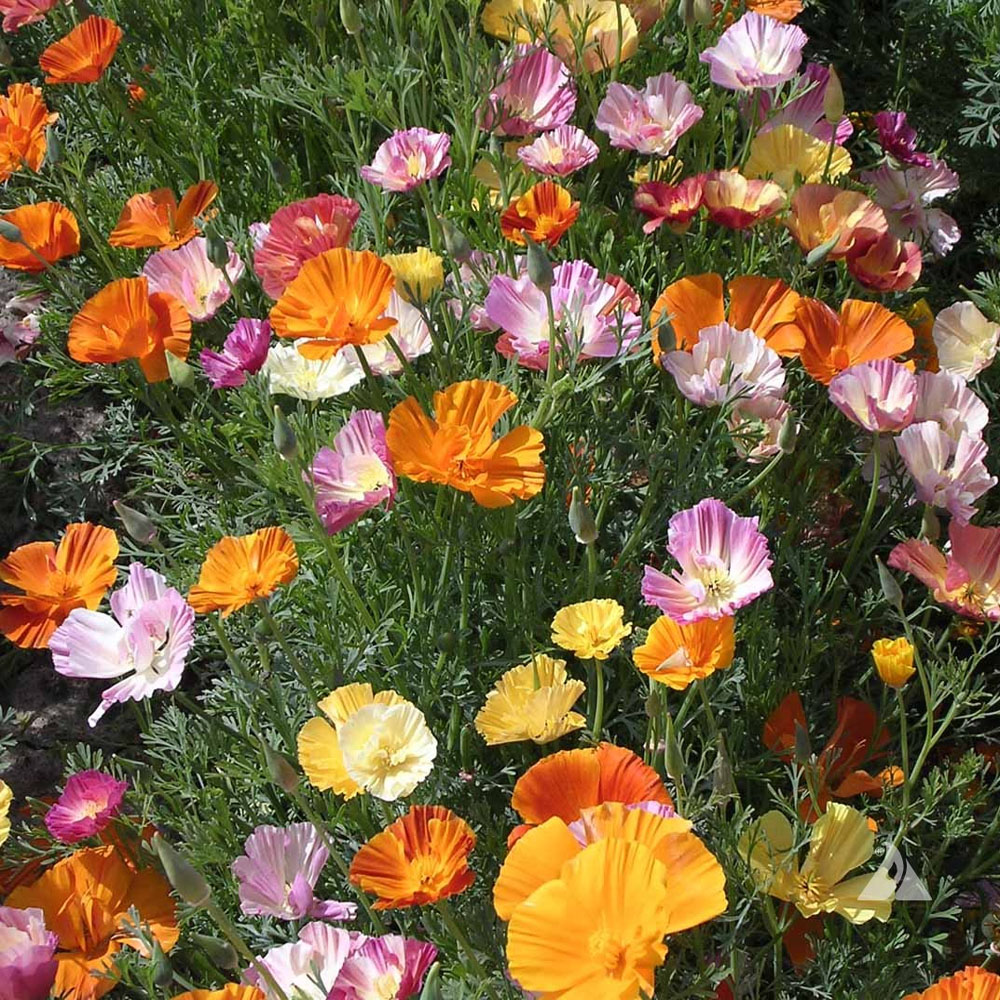
Poppy Seeds - California Ballerina Mix
About...
California Poppy (Eschscholzia Californica Ballerina Mix ) - Known for being a liberal self-sower, California Poppies very freely drop their own Poppy flower seeds. When Ballerina California Poppy flowers are planted in mass groupings, the visual appeal is amazing.MORE POPPY OPTIONS
Planting Directions
TEMPERATURE
60 - 70F
AVERAGE GERM TIME
14 - 28 days
LIGHT REQUIRED
Yes
DEPTH
1/8 inch
SOWING RATE
Approximately 5000 seeds cover 50 square feet
MOISTURE
Keep seeds moist until germination
PLANT SPACING
12 inches
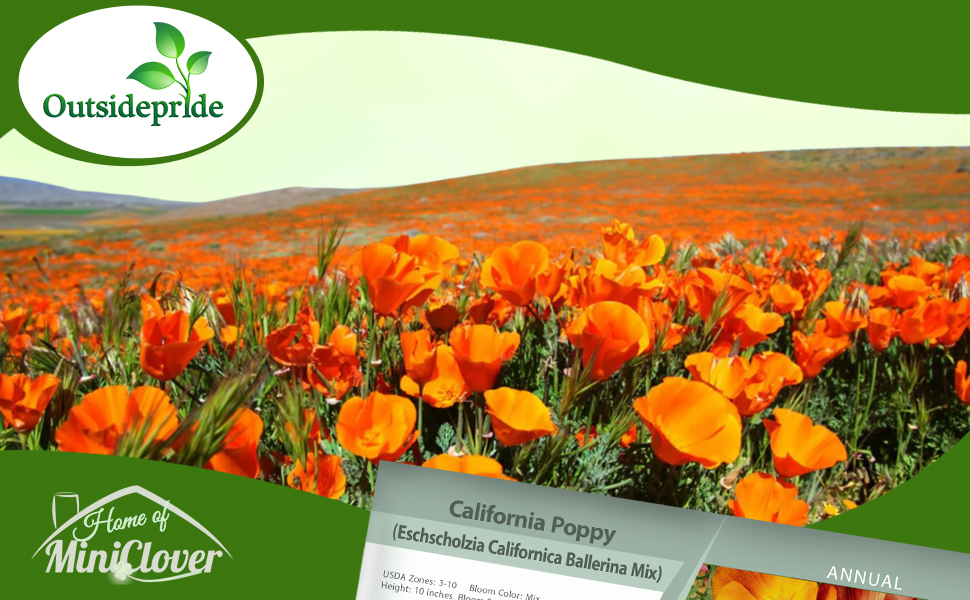
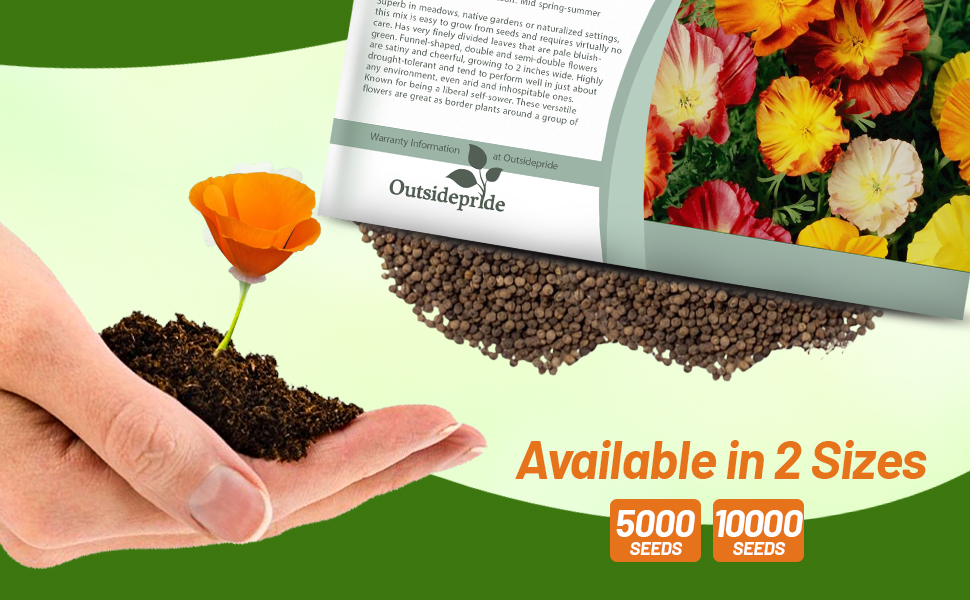
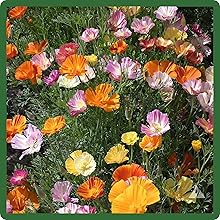
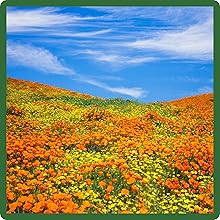
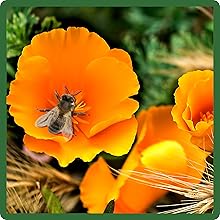
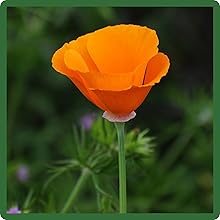
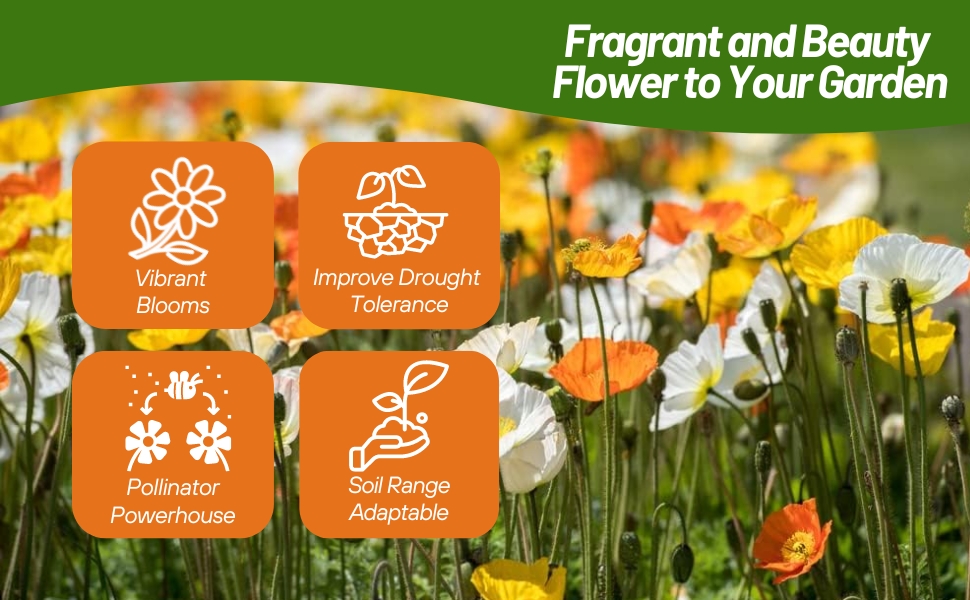
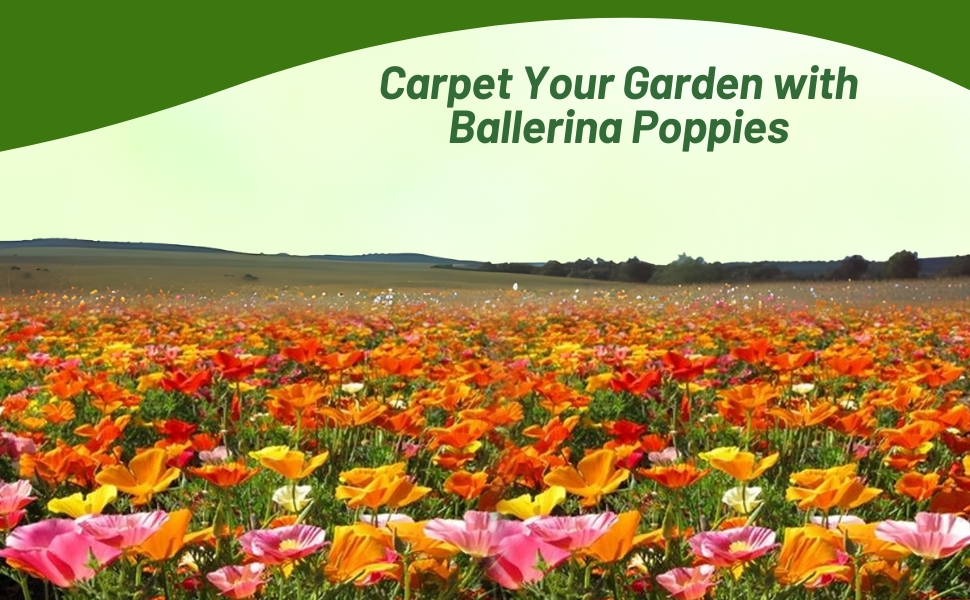
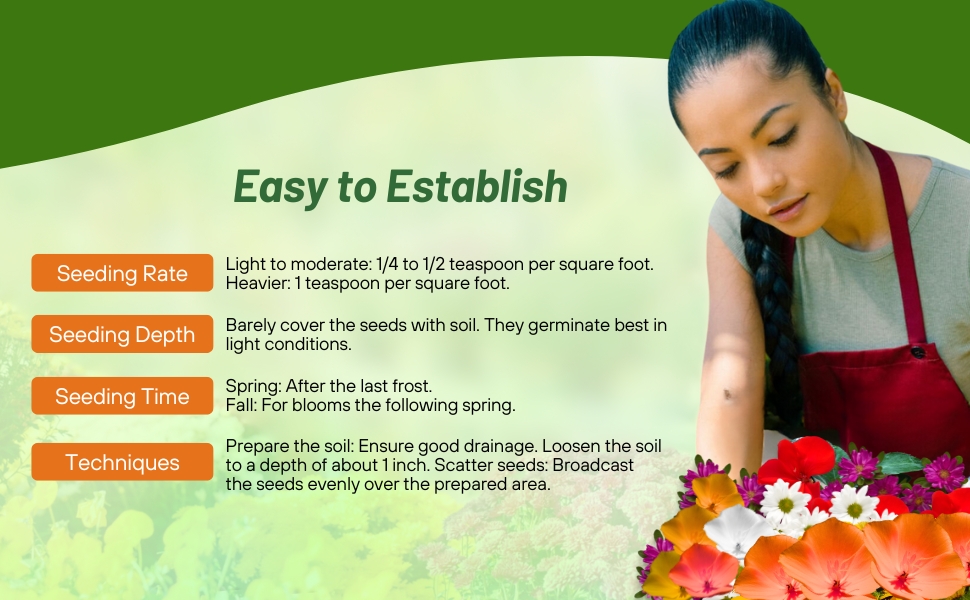
California Poppy (Eschscholzia Californica Ballerina Mix ) - Superb in meadows, native gardens or naturalized settings, this California Poppy mix is easy to grow from flower seeds and requires virtually no care or water. This Ballerina Poppy mix has very finely divided leaves that are pale bluish-green. The funnel-shaped, double and semi-double flowers are satiny and cheerful, growing to 2 inches wide. California Poppies are highly drought tolerant and tend to perform well in just about any environment, even arid and inhospitable ones. Known for being a liberal self-sower, California Poppies very freely drop their own Poppy flower seeds. When Ballerina California Poppy flowers are planted in mass groupings, the visual appeal is amazing. These versatile flowers are also great as border plants around a group of larger flowering plants. Perfect for xeriscaping.
Common Questions
Do I need to deadhead California poppy?
This is optional; however, it will extend your bloom season. Leaving on some spent flowers if you want to reseed for your next growing season.
Are these flowers fragrant?
They are not known for their scent, but they are valued highly for their cheerful blooms.
Can I grow in containers?
Yes, you can. Make sure to choose a container large enough for mature plants as California poppies do not like to be transplanted. Containers will need good drainage, and you will also need to water more frequently.
Are poppies deer resistant?
Yes, they do tend to be deer resistant.
Planting Directions
TEMPERATURE
55 - 60F
AVERAGE GERM TIME
21 - 28 days
LIGHT REQUIRED
Yes
DEPTH
Do not cover the seed but press into the soil
SOWING RATE
2/3 ounce per 1,000 square feet or 2 pounds per acre
MOISTURE
Keep seeds moist until germination
PLANT SPACING
12 inches


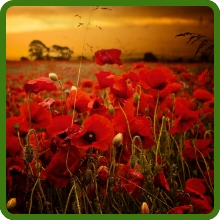
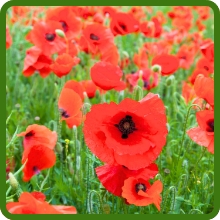
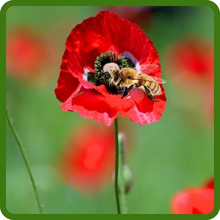
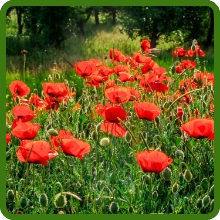
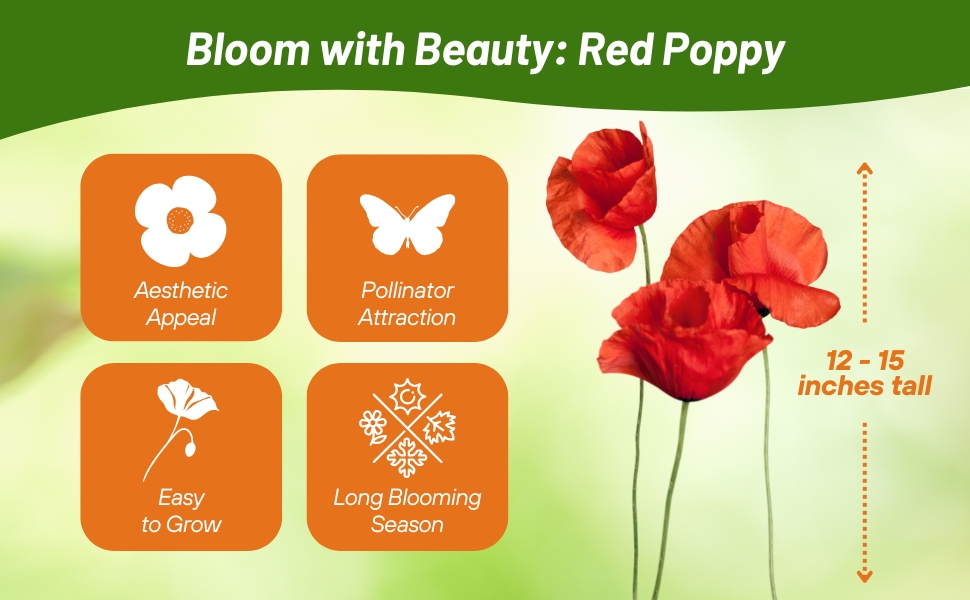

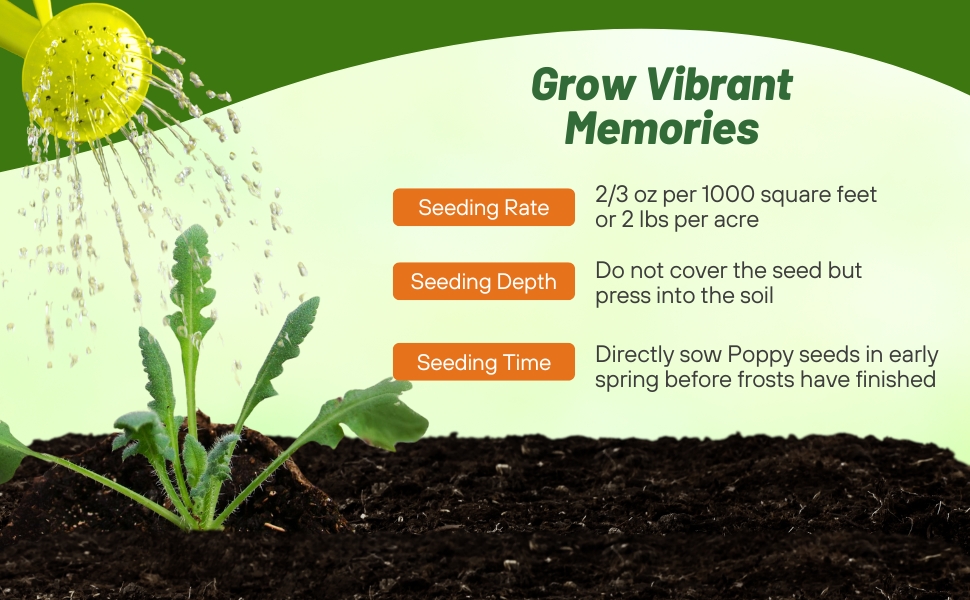
Red Poppy (Papaver Rhoeas) - The drought tolerant Red Poppy is one of the most popular wildflowers in all the world, and it easily establishes from Poppy seeds. It is also known as Shirley Poppy, Flanders Poppy, American Legion Poppy, (the red poppy is the symbol of the American Legion, handed out for Memorial Day), and in England, Corn Poppy. This wildflower is native to most of all Europe and North Africa. Growing Poppies from seed is such a rewarding experience. Red Poppies are favorites with xeriscape gardeners because they grow so successfully from wildflower seed, and they transform a dull boring landscape into an intense display of gorgeous red blooms. Since they are annuals, they grow quickly from flower seeds each spring and drop new Red Poppy wildflower seed in the fall.
Common Questions
Do I need to deadhead Papaver rhoeas?
This is optional; however, it will extend your bloom season.
Do I need to fertilizer Papaver rhoeas?
Typically, no. However, if you notice foliage and no flowers your plants may be in need of phosphorus-rich fertilizer.
Are these flowers fragrant?
They are not known for their scent, but they are valued highly for their blooms.
Planting Directions
TEMPERATURE
60F
AVERAGE GERM TIME
14 - 28 days
LIGHT REQUIRED
Yes
DEPTH
Surface sow up to 1/8th inch deep
SOWING RATE
5 - 6 seeds per plant
MOISTURE
Keep seeds moist until germination
PLANT SPACING
14 inches
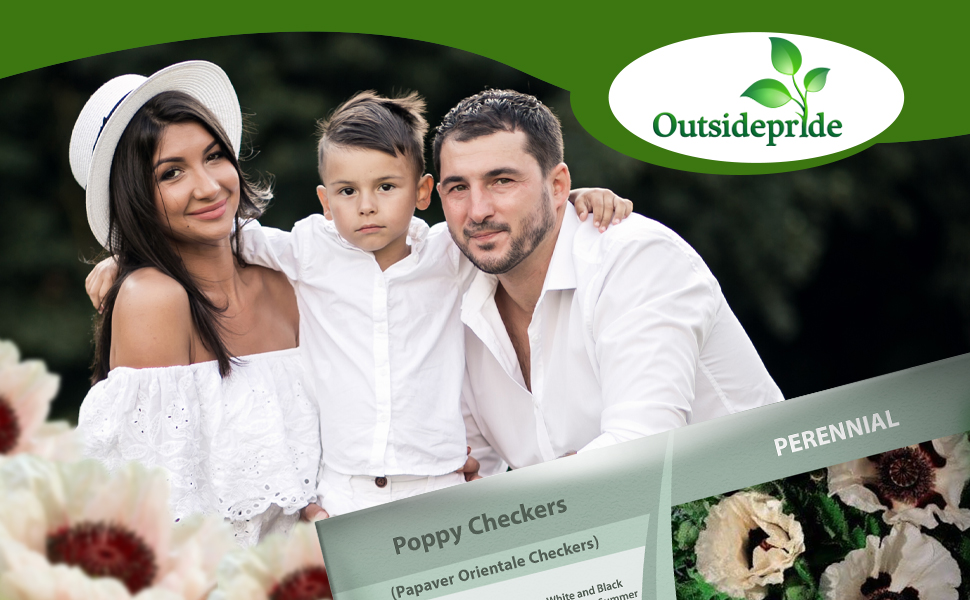
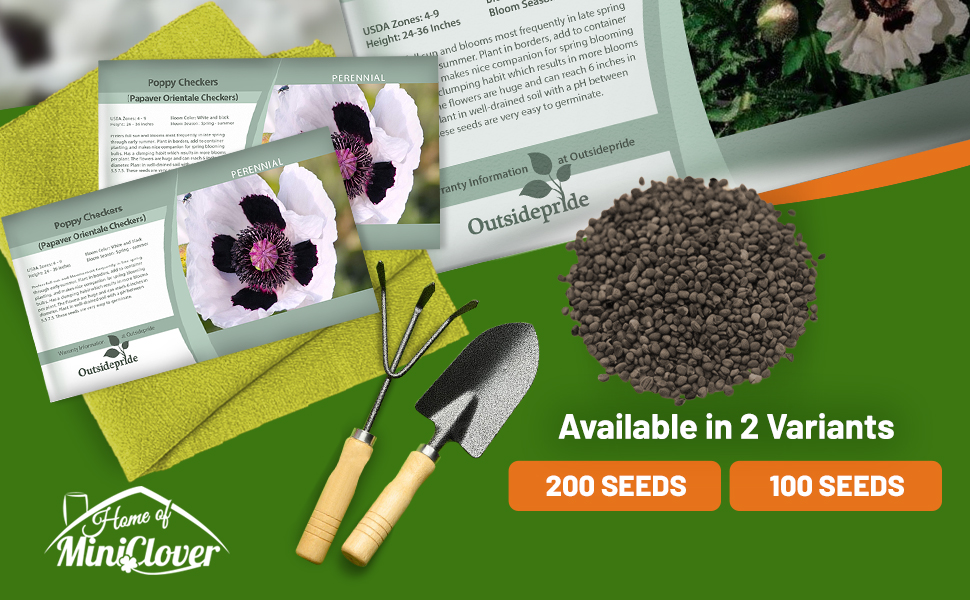
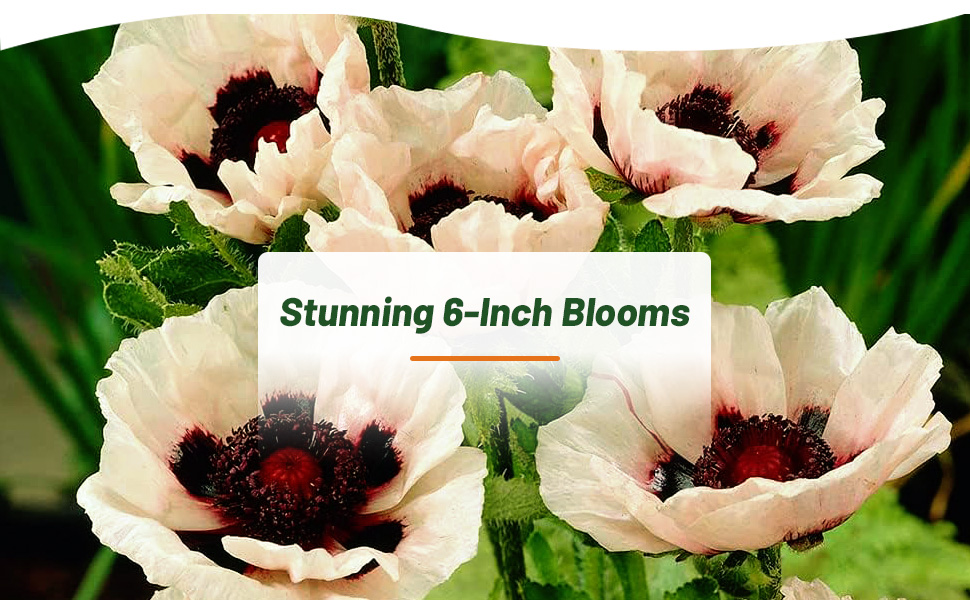
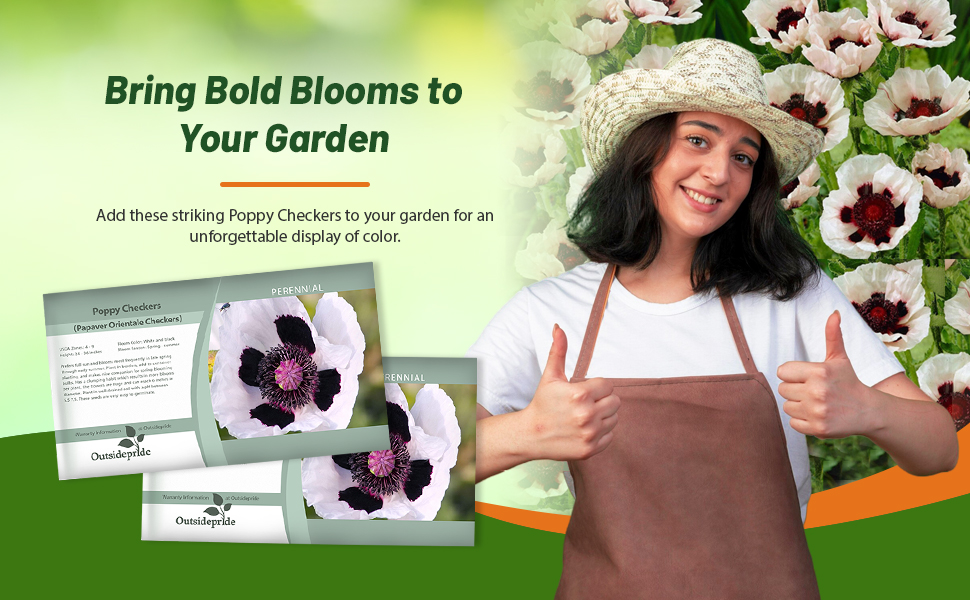
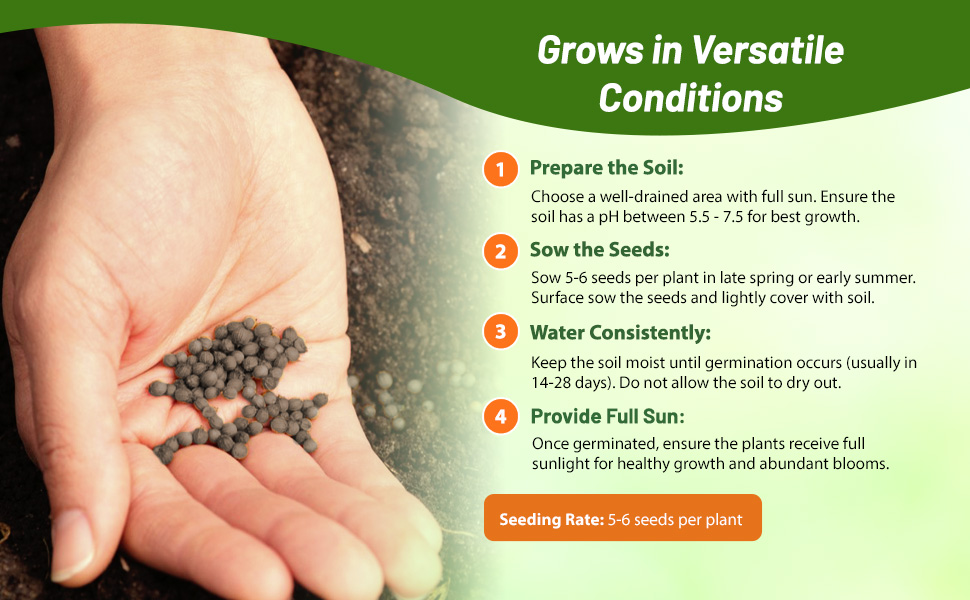
Poppy Checkers (Papaver Orientale Checkers) - This beautiful flowering poppy plant will grow 24 - 36 inches tall. It prefers full sun and blooms most frequently in late spring through early summer. Plant Papaver Checkers within the perennial border, add to container planting, and makes nice companion for spring blooming bulbs. This perennial poppy has a clumping habit which results in more blooms per plant. The poppy flowers are huge and can reach 6 inches in diameter. Plant these poppy seeds in well-drained soil with a pH between 5.5 - 7.5. These flower seeds are very easy to germinate.
Common Questions
Do I need to fertilize oriental poppy?
Use a slow-release fertilizer in the spring. Be sure to follow product label directions. Another option is to side dress the soil with compost or manure tea.
Can I grow oriental poppy in a container?
Yes, however it is not ideal. These plants have a long tap root that do much better in garden soil. If containers are still something you would like to try choosing a container deep enough to handle the long tap root (terra cotta pots are best). Use quality potting mix with slow-release fertilizer, water deeply and always keep soil moist.
Do I need to winterize my oriental poppy plants?
Oriental poppies are winter hardy to USDA zone 8, they do benefit from a layer of mulch before winter sets in to protect the roots. If you are growing your flowers in a container, you can bury the container in garden soil or wrap with burlap or bubble wrap for protection. They can also be moved indoors.
Should Oriental poppies be cut back?
There's no need to trim them back, as the foliage naturally dies off after blooming. However, if you prefer a tidier look, you can cut the wilted leaves down to the ground.
Will Oriental poppies bloom in the first year?
The timing of when you plant the seeds is crucial. They require a cold period to flourish, so if you sow them in the spring, they won’t bloom until the next year.
Planting Directions
TEMPERATURE
60 - 65F
AVERAGE GERM TIME
14 - 21 days
LIGHT REQUIRED
Yes
DEPTH
Surface sow seeds just barely covering
SOWING RATE
3 - 4 seeds per plant
MOISTURE
Keep seeds moist until germination
PLANT SPACING
8 - 10 inches
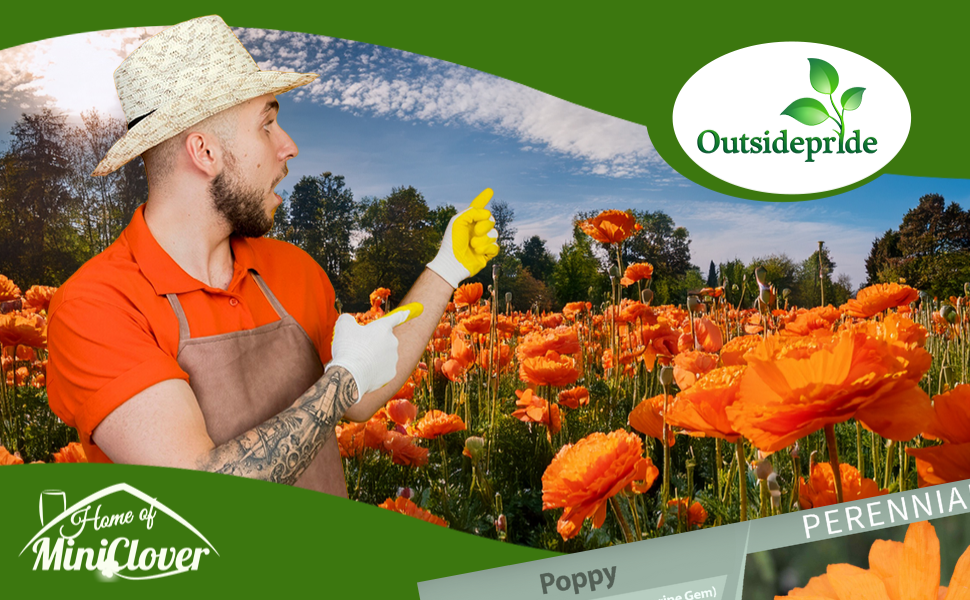
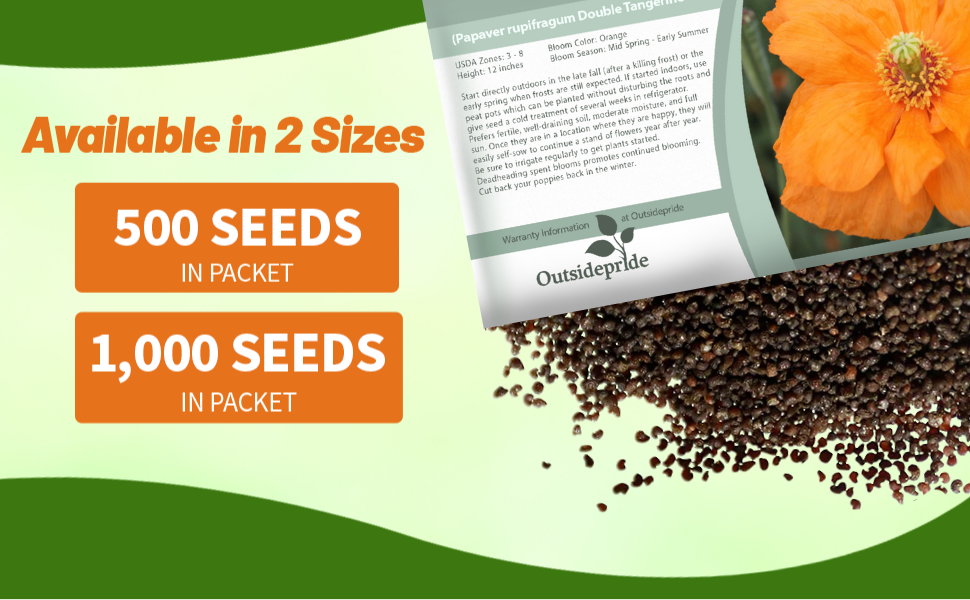
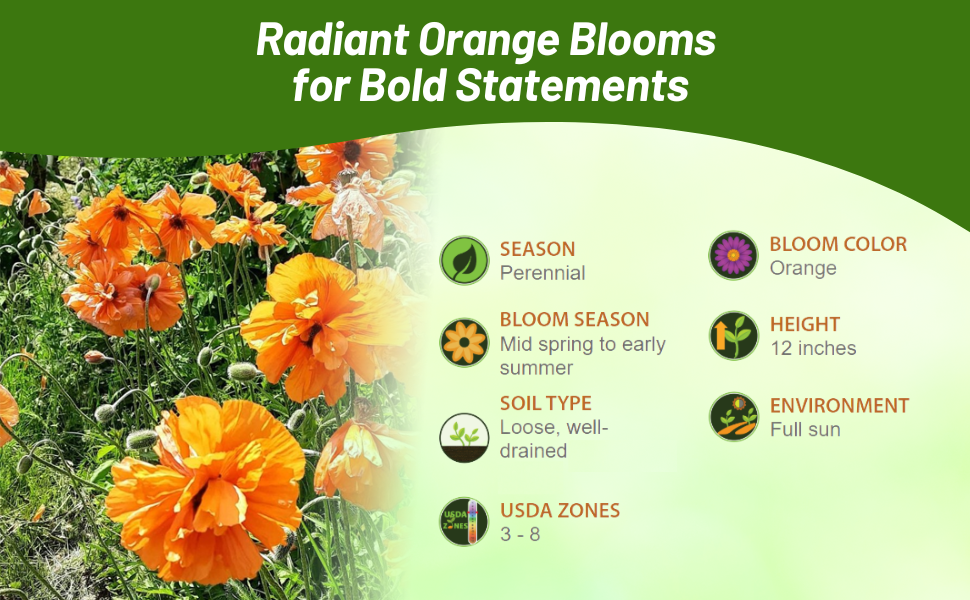
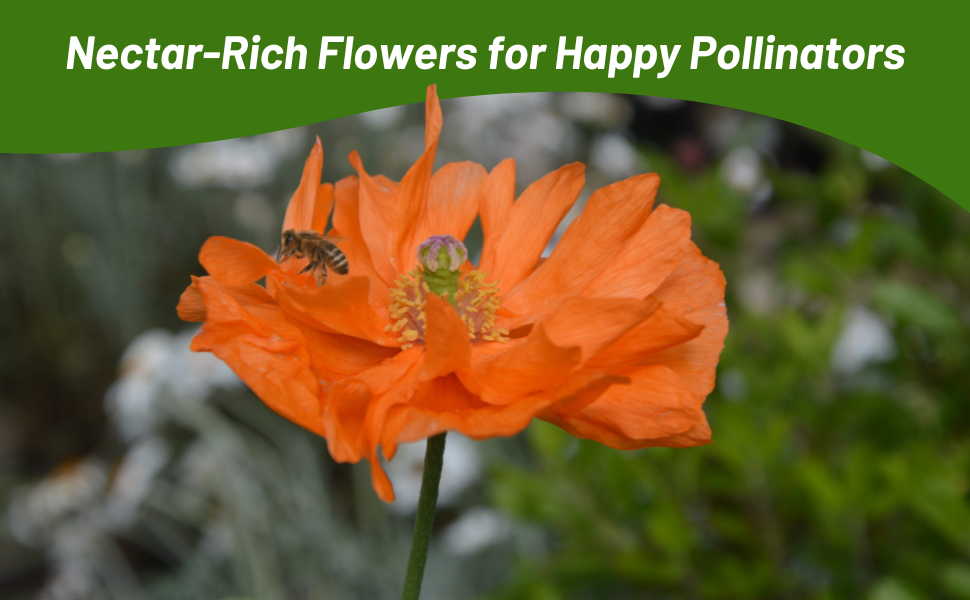
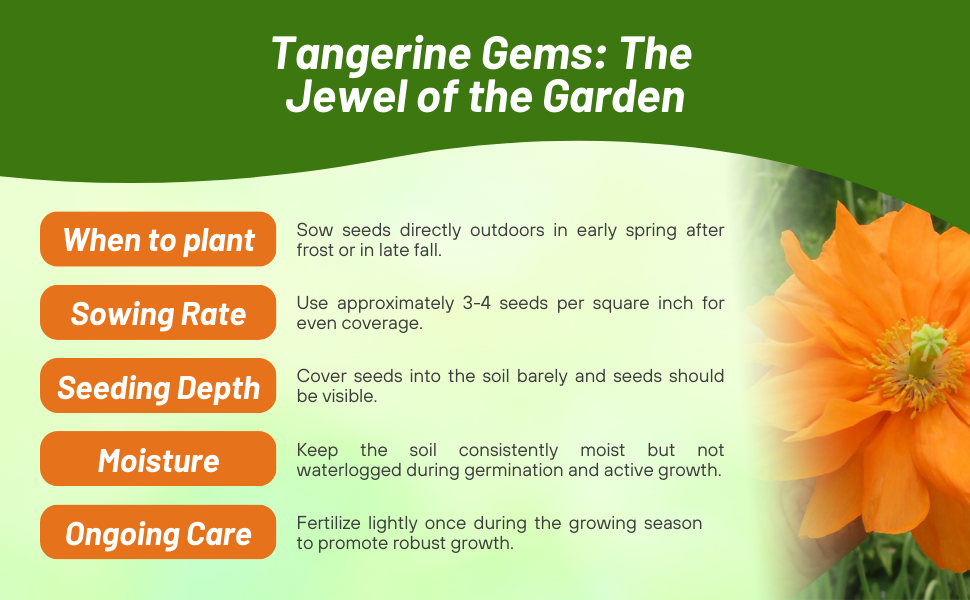
Poppy (Papaver rupifragum Double Tangerine Gem) - This perennial flower is a native of Morocco and brings saturated tangerine tones to the most rocky and arid landscapes. Fully double orange blooms of overlapping rings of paper-thin silky petals with Ferny, silver-blue foliage only growing 12 inches tall. Sunlight makes the translucent petals of Papaver Double Tangerine positively glow with color. The fascinating attractive seedpods will add a nice touch to dried arrangements. This cute little robust plant looks best in a rock garden or edging a hot, sunny border.
This pollinator-attracting blooms in the first year and reseeds readily. In 1890, Sir William Jackson Hooker described finding P. rupifragum growing in dry, rocky places of southern Morocco at an elevation of 6,000 - 7,000 feet. Indeed, this drought-tolerant plant is perfect for meadows, xeriscaping, rocky gardens, and sunny, dry locations!
Common Questions
Are Papaver rupifragum easy to grow?
Yes, these plants are easy to grow in your garden or container.
Can I grow Papaver rupifragum in container?
Yes, these do well in containers.
What are some good ways to use these flowers around my garden?
Beds and borders, cottage gardens, rock gardens or containers are all great ways to use Papaver rupifragum.
Planting Directions
TEMPERATURE
60 - 70F
AVERAGE GERM TIME
14 - 21 days
LIGHT REQUIRED
Yes
DEPTH
1/4 inch
SOWING RATE
3 - 4 seeds per plant
MOISTURE
Keep seeds moist until germination
PLANT SPACING
10 inches
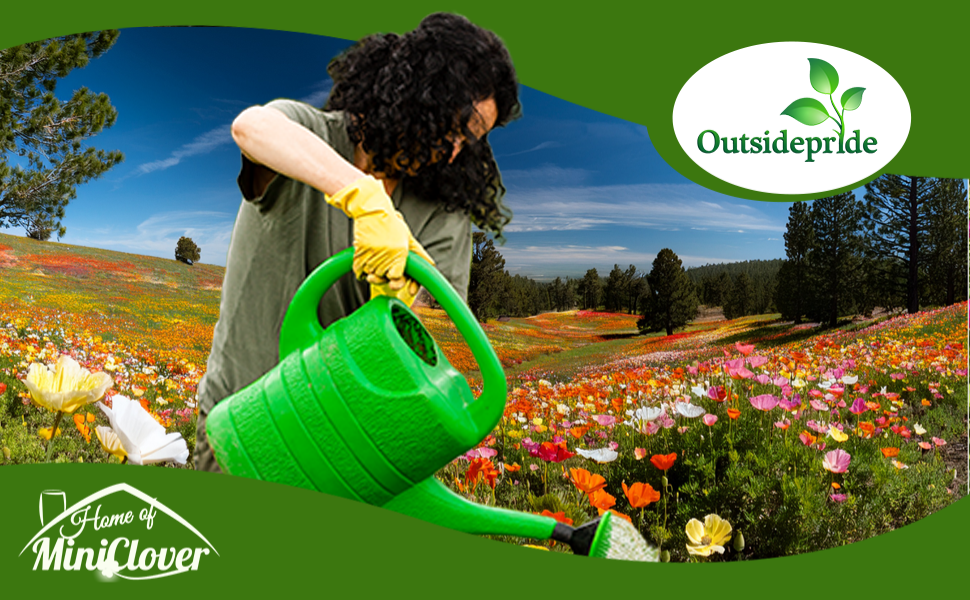
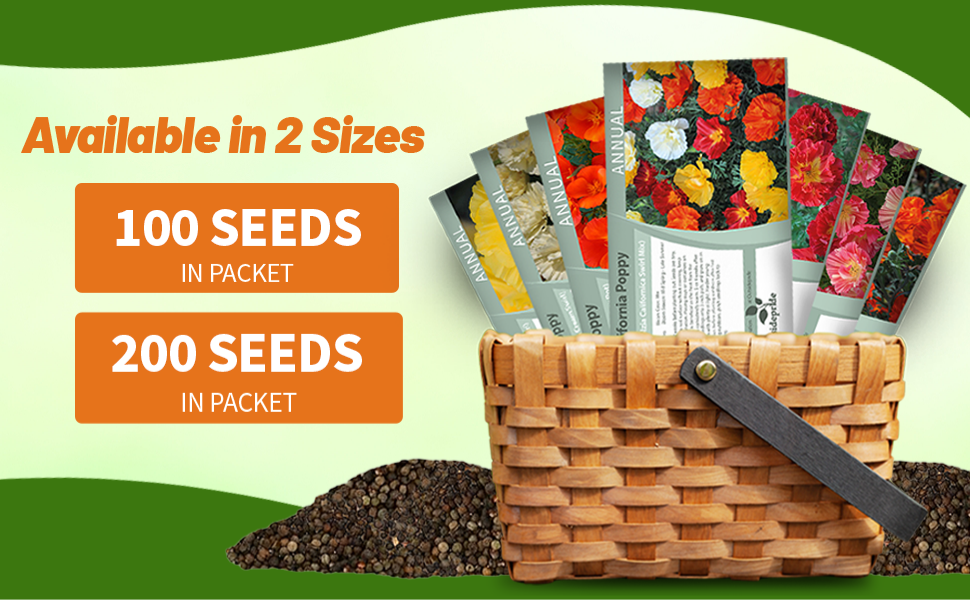
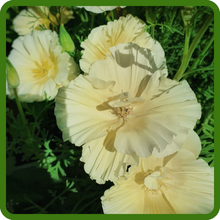
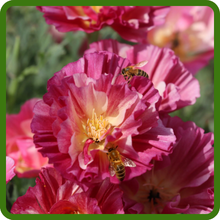
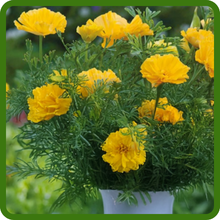
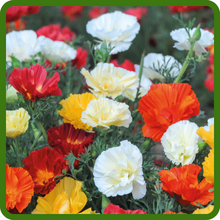
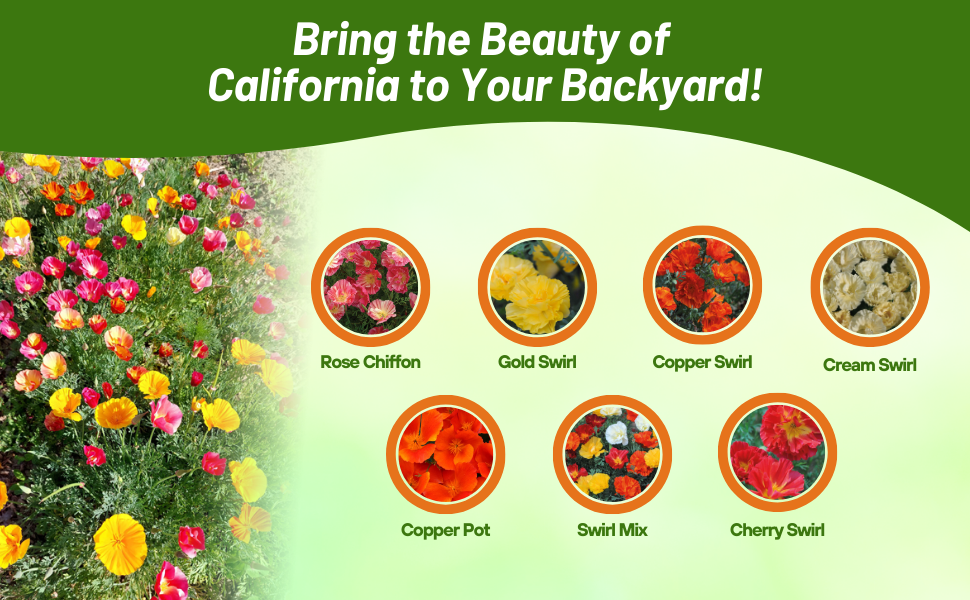
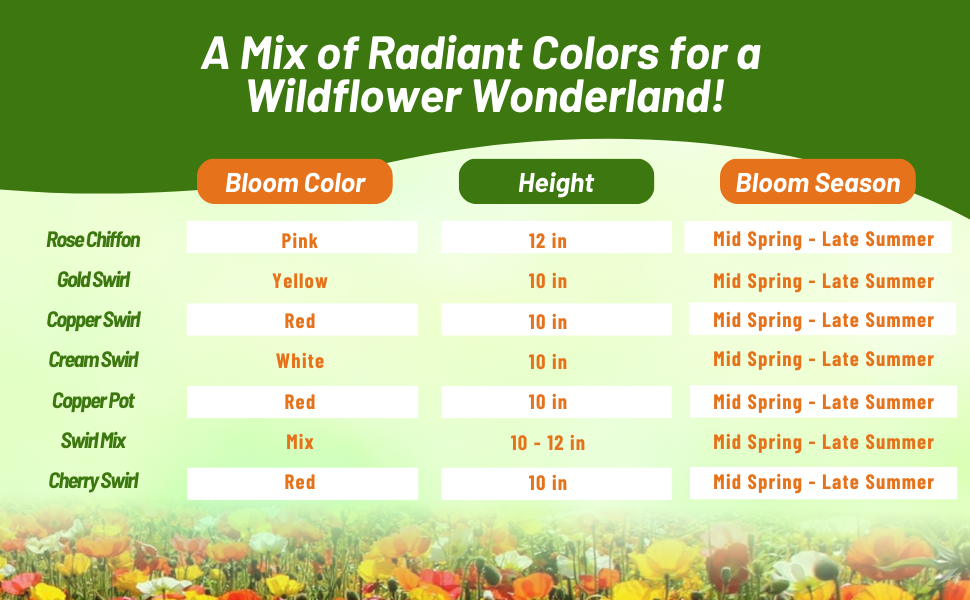
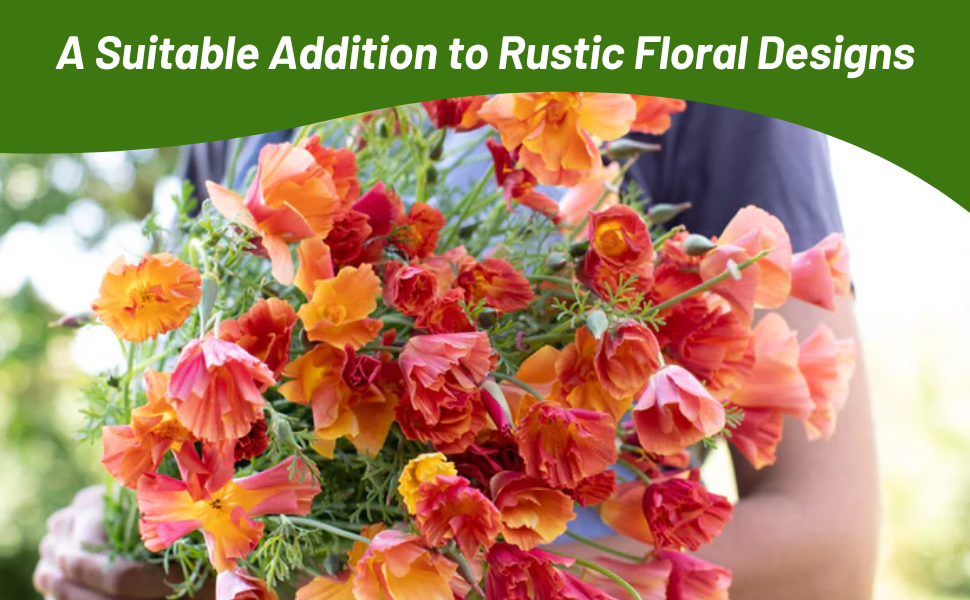
California Poppy (Eschscholzia Californica Swirl Mix) - A bright formula mix of all the 'Swirl' colors including: Cherry, Copper , Cream, & Gold. The attractive double flowers are produced above feathery blue/green foliage. As an added bonus, they are also drought tolerant and thrive in almost any soil type reaching 10 - 12 inches in height.
These dainty hardy annuals are tougher than they appear and positively thrive on poor, dry soils. California poppies are easy to grow in beds and borders, or let them self seed throughout gravel gardens to form natural drifts. A plant that enjoys a sunny site with poor, well-drained soil. Honey bees, bumblebees & sweat bees all seek its nectar while some local butterflies will also seek out this nutrition. This poppy is ideal for adding color to any sunny location, it can establish in a problem area & it seems to happily harmonize with annuals & perennials alike. Ideal for a container too! Plant in any fast-draining soil in full sun and as with most poppies it is considererd deer resistant.
Common Questions
Do I need to deadhead California poppy?
This is optional; however, it will extend your bloom season. Leaving on some spent flowers if you want to reseed for your next growing season.
Are these flowers fragrant?
They are not known for their scent, but they are valued highly for their cheerful blooms.
Can I grow in containers?
Yes, you can. Make sure to choose a container large enough for mature plants as California poppies do not like to be transplanted. Containers will need good drainage, and you will also need to water more frequently.
Are poppies deer resistant?
Yes, they do tend to be deer resistant.
Planting Directions
TEMPERATURE
60 - 70F
AVERAGE GERM TIME
14 - 21 days
LIGHT REQUIRED
Yes
DEPTH
1/4 inch
SOWING RATE
3 - 4 seeds per plant
MOISTURE
Keep seeds moist until germination
PLANT SPACING
10 inches
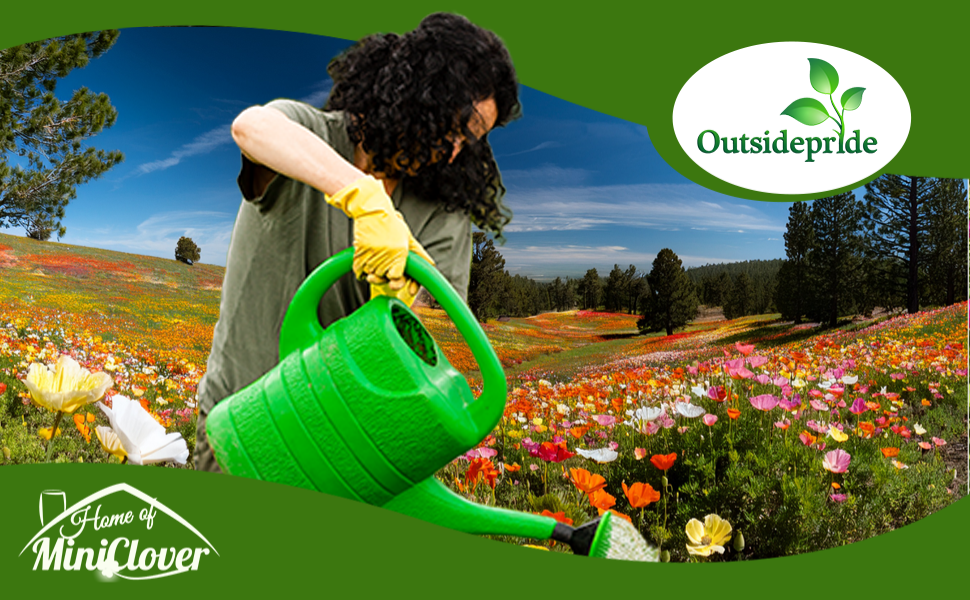
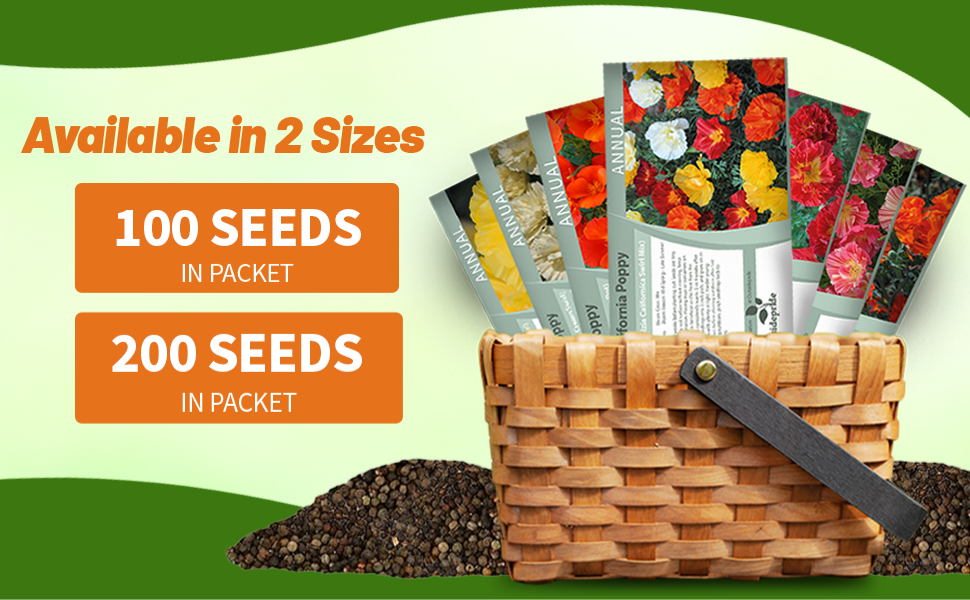
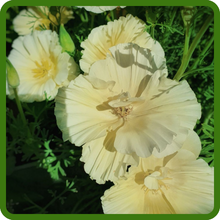
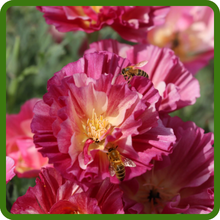
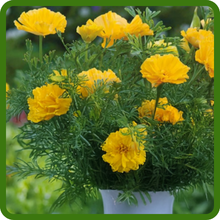
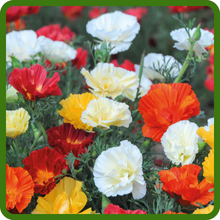
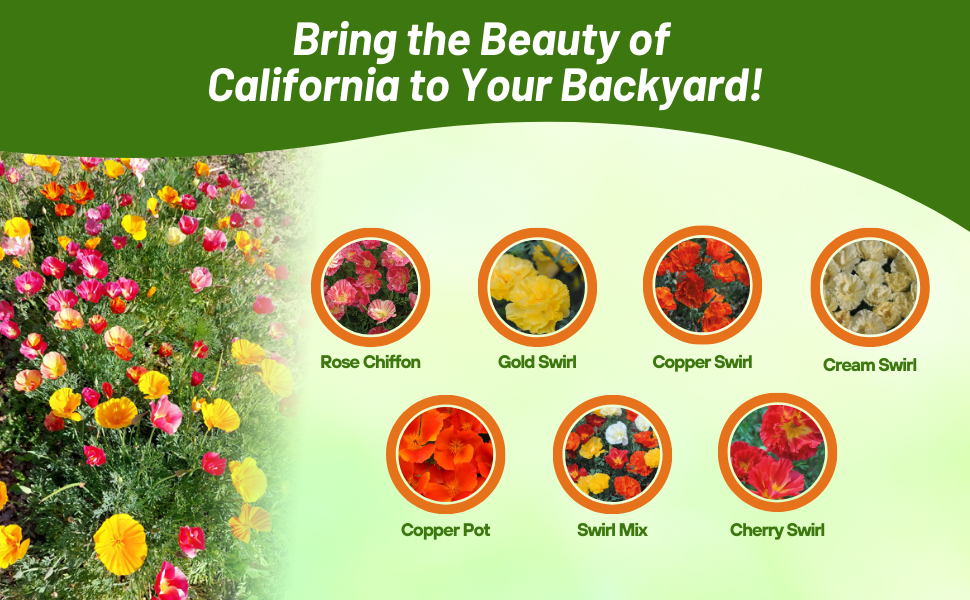
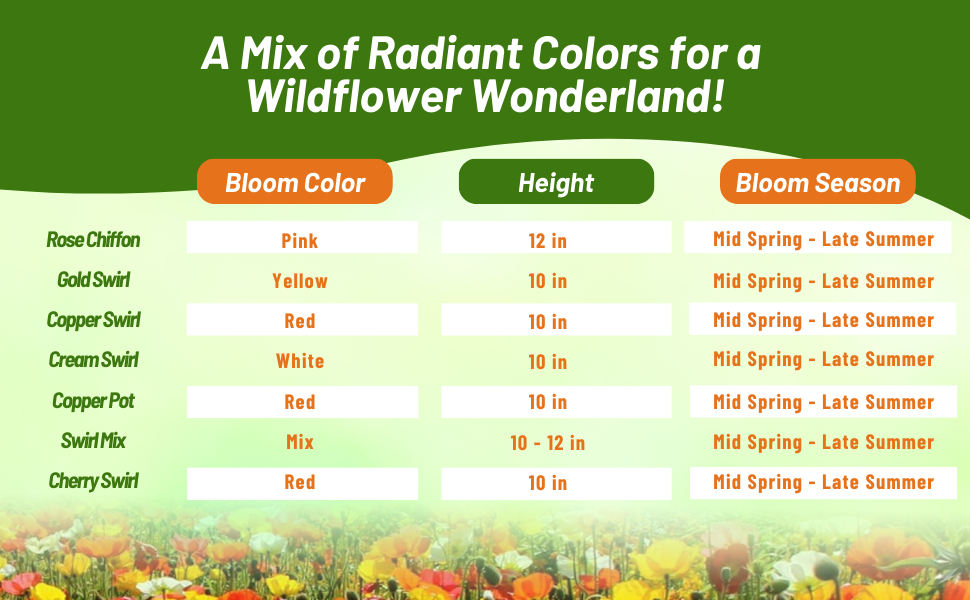
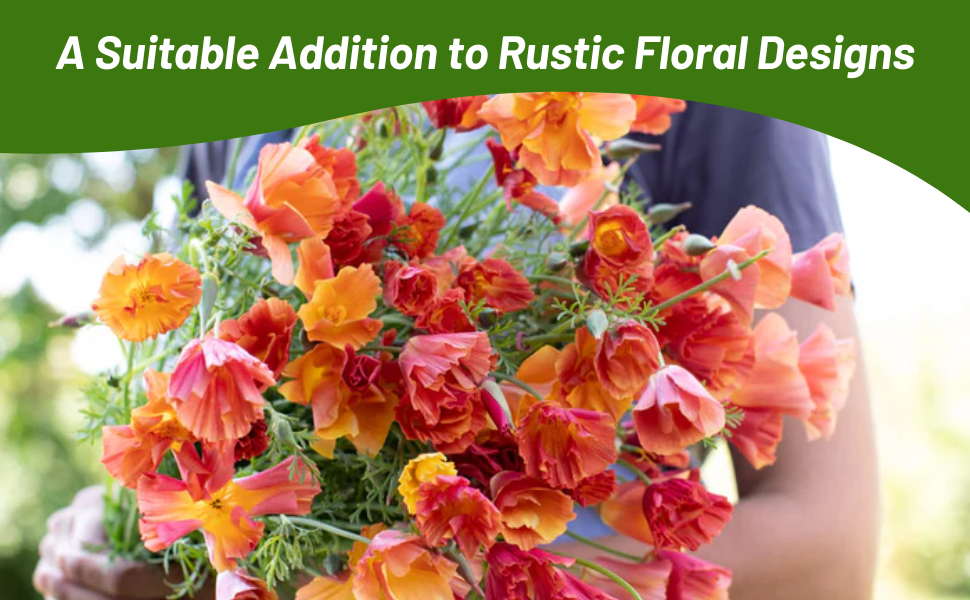
California Poppy (Eschscholzia Californica Rose Chiffon) - These amazing, easy to grow hardy annuals are certain to create a huge impact in your summer displays. Beautiful, semi-double, pink flowers each with delightfully frilled outer petals and a creamy golden eye are certain to be show stoppers in any bed or border. As an added bonus, they are also drought tolerant and thrive in almost any soil type.
These dainty hardy annuals are tougher than they appear and positively thrive on poor, dry soils. California poppies are easy to grow in beds and borders, or let them self seed throughout gravel gardens to form natural drifts. A plant that enjoys a sunny site with poor, well-drained soil. Honey bees, bumblebees & sweat bees all seek its nectar while some local butterflies will also seek out this nutrition. This poppy is ideal for adding color to any sunny location, it can establish in a problem area & it seems to happily harmonize with annuals & perennials alike. Ideal for a container too! Plant in any fast-draining soil in full sun and as with most poppies it is considererd deer resistant.
Common Questions
Do I need to deadhead California poppy?
This is optional; however, it will extend your bloom season. Leaving on some spent flowers if you want to reseed for your next growing season.
Are these flowers fragrant?
They are not known for their scent, but they are valued highly for their cheerful blooms.
Can I grow in containers?
Yes, you can. Make sure to choose a container large enough for mature plants as California poppies do not like to be transplanted. Containers will need good drainage, and you will also need to water more frequently.
Are poppies deer resistant?
Yes, they do tend to be deer resistant.
Planting Directions
TEMPERATURE
60 - 70F
AVERAGE GERM TIME
14 - 21 days
LIGHT REQUIRED
Yes
DEPTH
1/4 inch
SOWING RATE
3 - 4 seeds per plant
MOISTURE
Keep seeds moist until germination
PLANT SPACING
10 inches
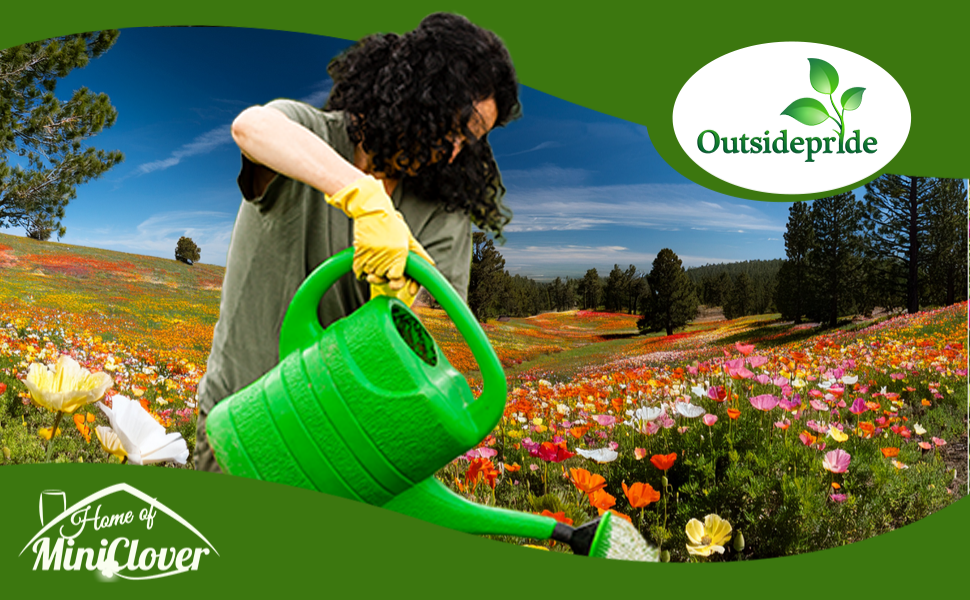
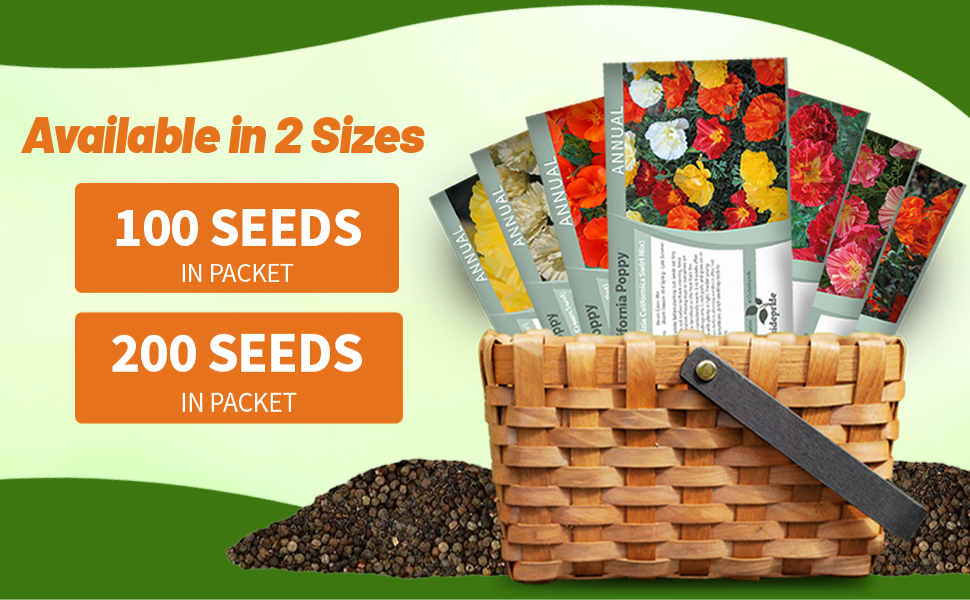
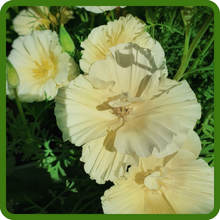
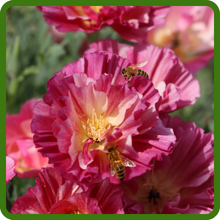
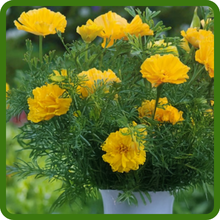
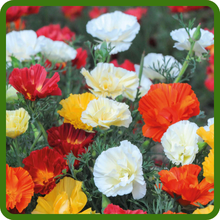
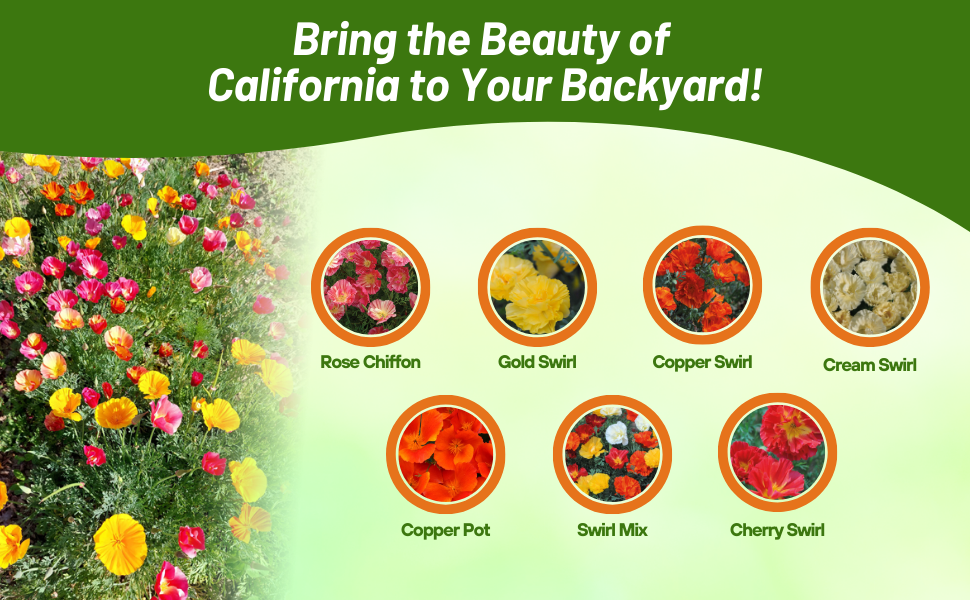
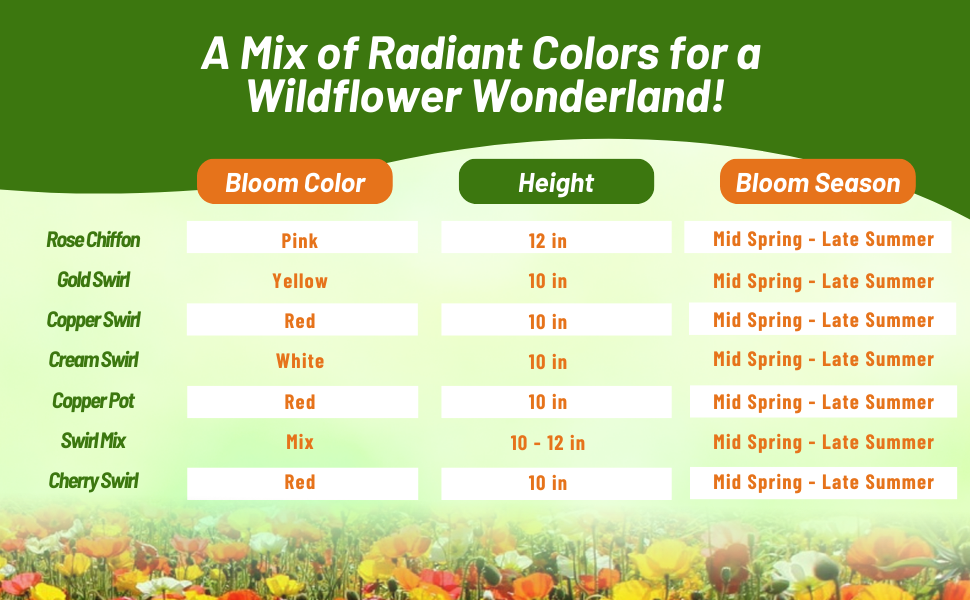
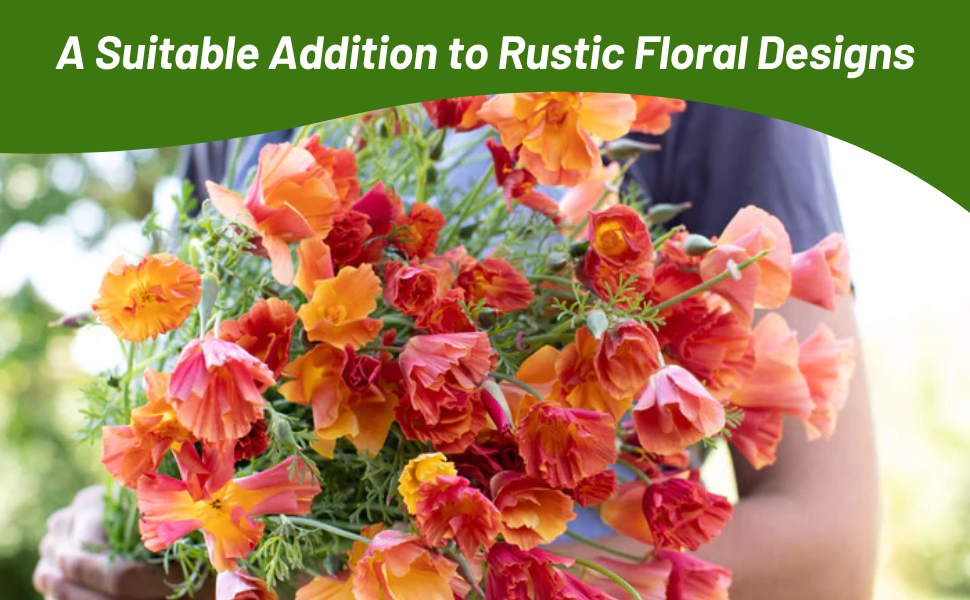
California Poppy (Eschscholzia Californica Gold Swirl) - Gold Swirl provides a long bloom season of golden yellow flowers. Easy to sow, easy to grow, drought tolerant, and deer resistant. Features Ruffled, double and semi-double, 2 - 3 inch flowers on compact, 10 inch tall plants. A new addition from the marvellous Thompson and Morgan breeding program, 'Gold Swirl' has rich yellow flowers for months on end.
These dainty hardy annuals are tougher than they appear and positively thrive on poor, dry soils. California poppies are easy to grow in beds and borders, or let them self seed throughout gravel gardens to form natural drifts. A plant that enjoys a sunny site with poor, well-drained soil. Honey bees, bumblebees & sweat bees all seek its nectar while some local butterflies will also seek out this nutrition. This poppy is ideal for adding color to any sunny location, it can establish in a problem area & it seems to happily harmonize with annuals & perennials alike. Ideal for a container too! Plant in any fast-draining soil in full sun and as with most poppies it is considererd deer resistant.
Common Questions
Do I need to deadhead California poppy?
This is optional; however, it will extend your bloom season. Leaving on some spent flowers if you want to reseed for your next growing season.
Are these flowers fragrant?
They are not known for their scent, but they are valued highly for their cheerful blooms.
Can I grow in containers?
Yes, you can. Make sure to choose a container large enough for mature plants as California poppies do not like to be transplanted. Containers will need good drainage, and you will also need to water more frequently.
Are poppies deer resistant?
Yes, they do tend to be deer resistant.
Planting Directions
TEMPERATURE
60 - 70F
AVERAGE GERM TIME
14 - 21 days
LIGHT REQUIRED
Yes
DEPTH
1/4 inch
SOWING RATE
3 - 4 seeds per plant
MOISTURE
Keep seeds moist until germination
PLANT SPACING
10 inches
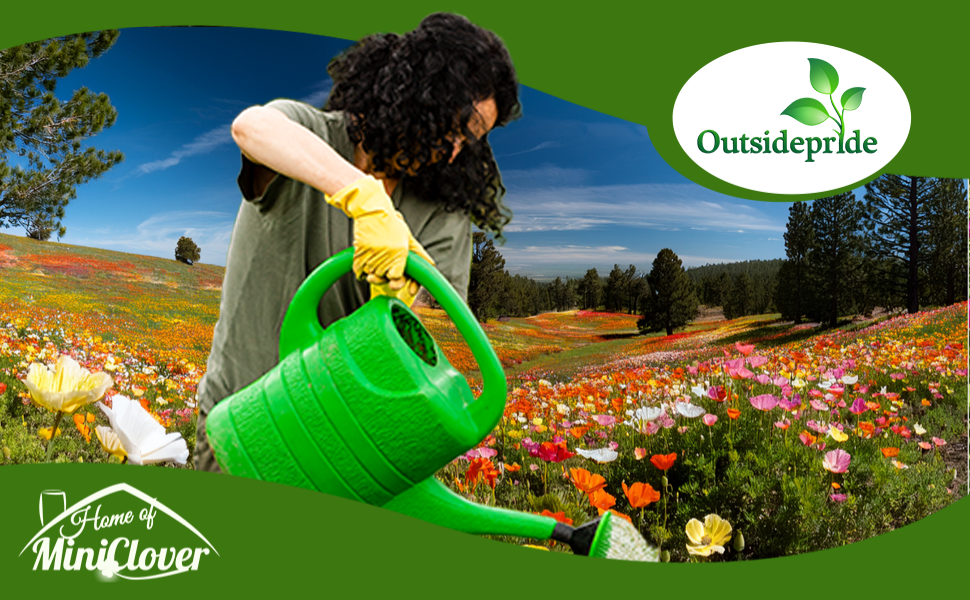
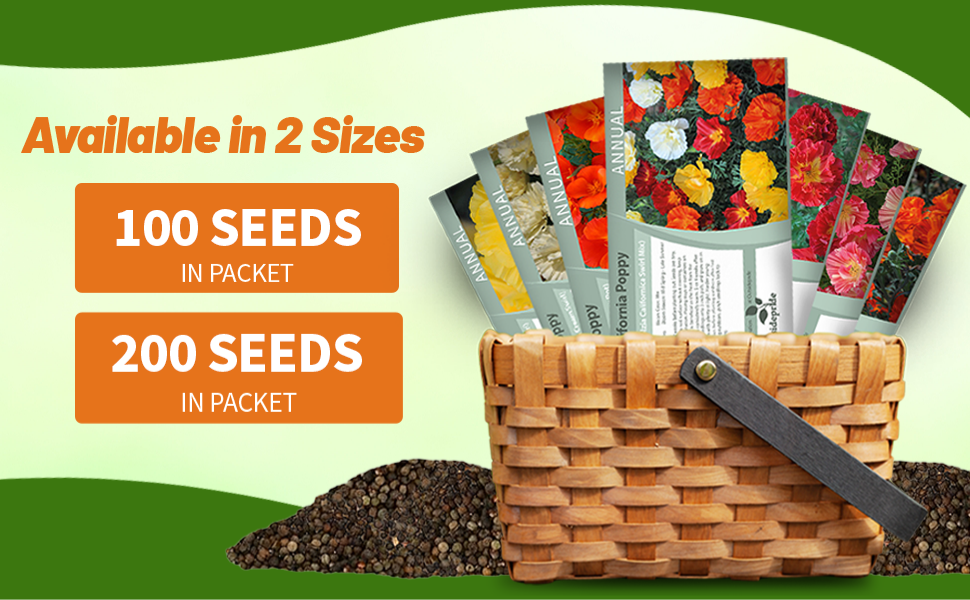
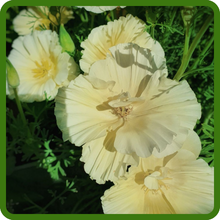
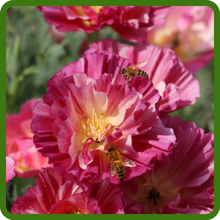
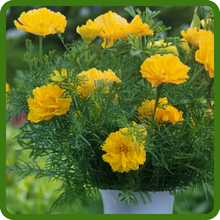
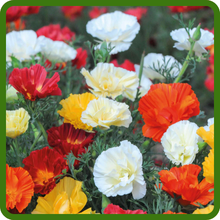
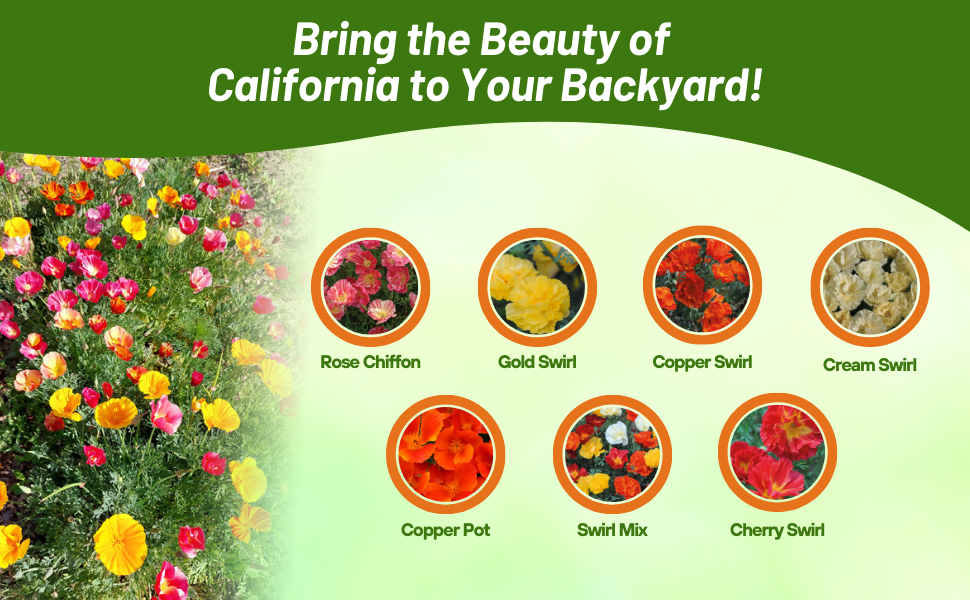
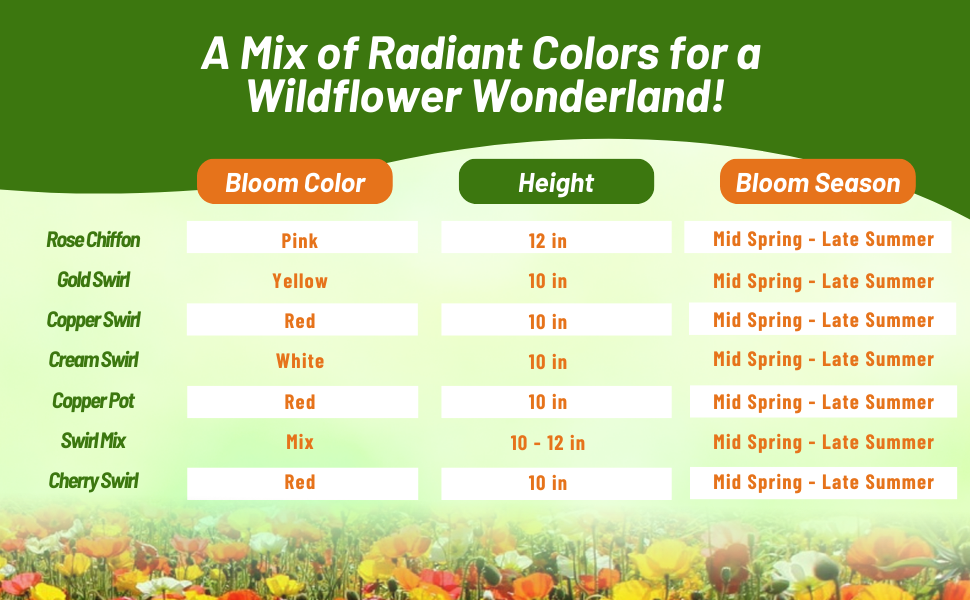
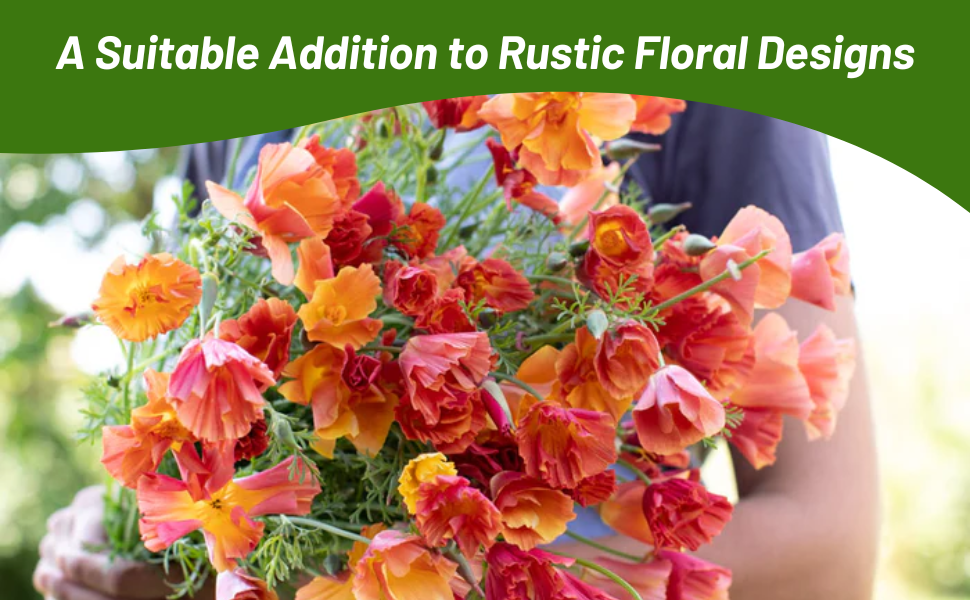
California Poppy (Eschscholzia Californica Cream Swirl) - An excellent selection of double cream flowers, brightening up borders. California poppies are very romantic and silk like flowers. Cream swirl gives soft buttercream-yellow ruffled petals. Due to the shorter stems, California poppies are fantastic plants for the front of the border. The romantic feel and soft color make this variety great as wedding flowers. Fleuroselect Novelty Award Winner.
These dainty hardy annuals are tougher than they appear and positively thrive on poor, dry soils. California poppies are easy to grow in beds and borders, or let them self seed throughout gravel gardens to form natural drifts. A plant that enjoys a sunny site with poor, well-drained soil. Honey bees, bumblebees & sweat bees all seek its nectar while some local butterflies will also seek out this nutrition. This poppy is ideal for adding color to any sunny location, it can establish in a problem area & it seems to happily harmonize with annuals & perennials alike. Ideal for a container too! Plant in any fast-draining soil in full sun and as with most poppies it is considererd deer resistant.
Common Questions
Do I need to deadhead California poppy?
This is optional; however, it will extend your bloom season. Leaving on some spent flowers if you want to reseed for your next growing season.
Are these flowers fragrant?
They are not known for their scent, but they are valued highly for their cheerful blooms.
Can I grow in containers?
Yes, you can. Make sure to choose a container large enough for mature plants as California poppies do not like to be transplanted. Containers will need good drainage, and you will also need to water more frequently.
Are poppies deer resistant?
Yes, they do tend to be deer resistant.
































